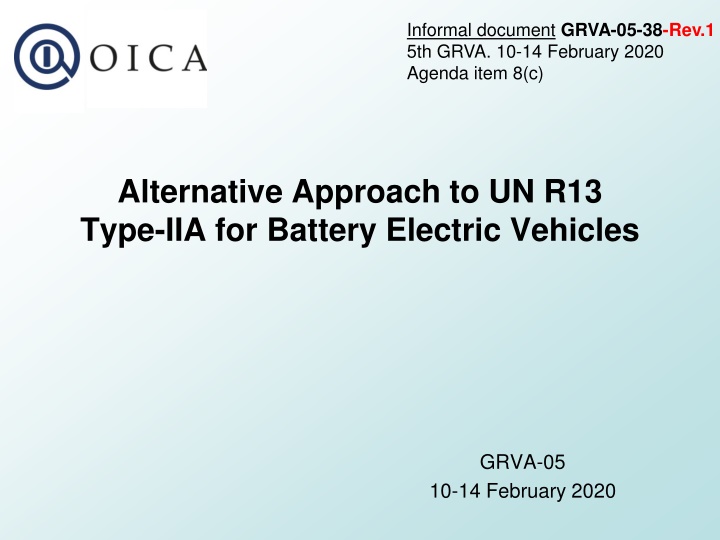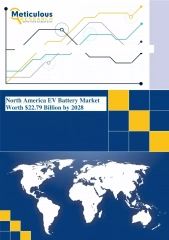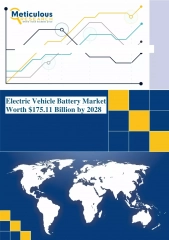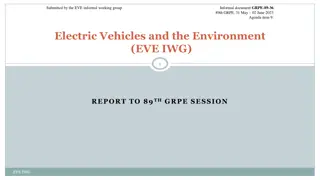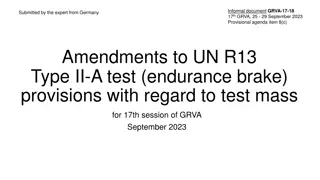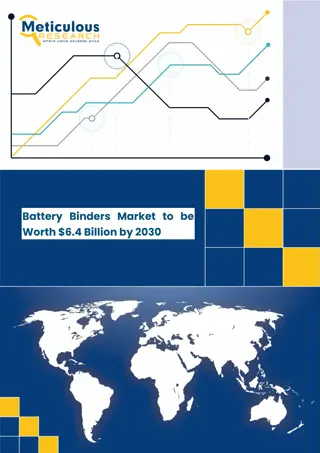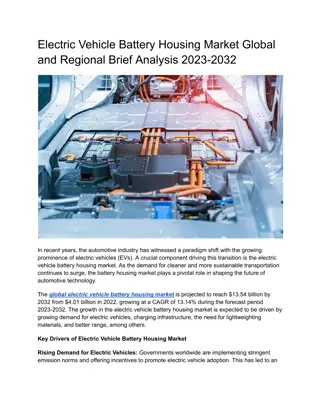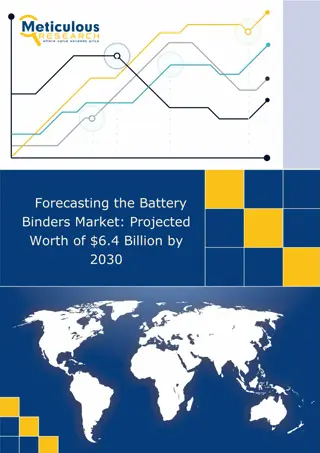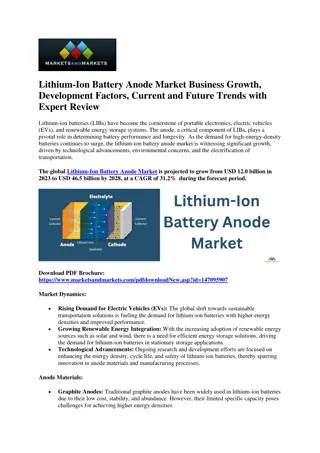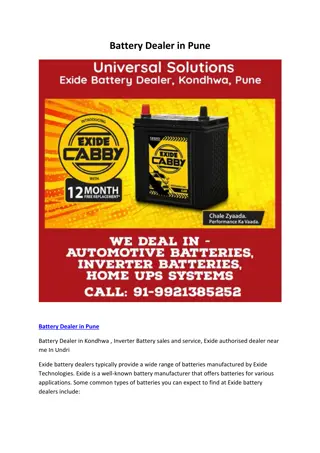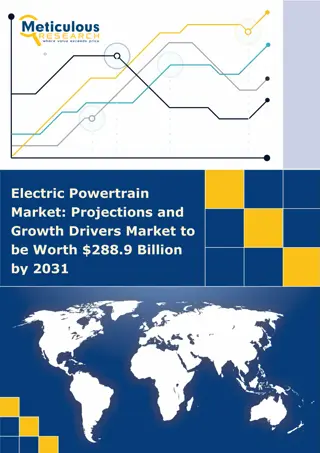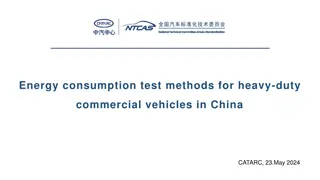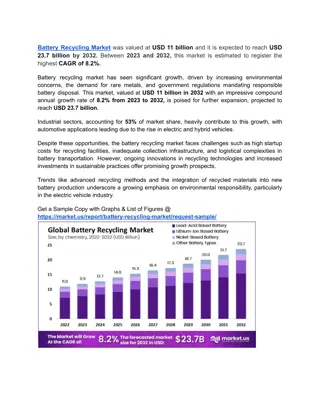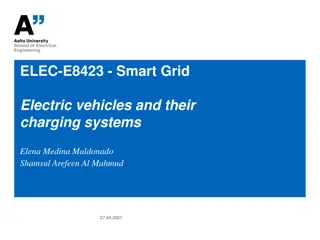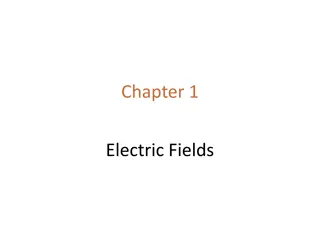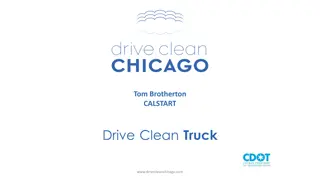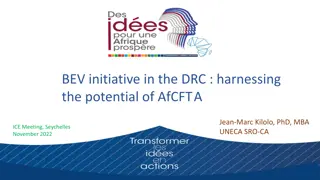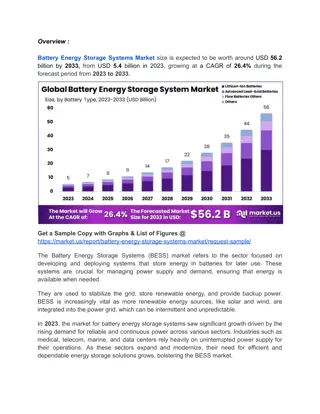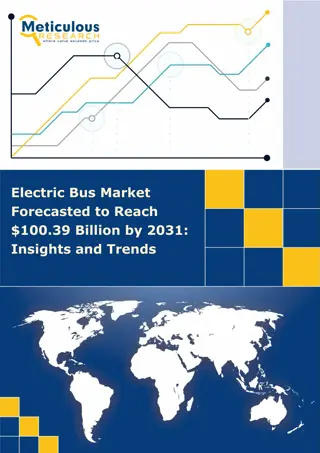Alternative Approach to UN R13 Type-IIA for Battery Electric Vehicles
OICA proposes an alternative approach to address the technical issue of Battery Electric Vehicles passing the Type-IIA test with a fully loaded battery. The aim is to define a regulatory framework enabling the development of electric solutions for heavy vehicles, ensuring safety and efficiency while optimizing battery capacity usage.
Download Presentation

Please find below an Image/Link to download the presentation.
The content on the website is provided AS IS for your information and personal use only. It may not be sold, licensed, or shared on other websites without obtaining consent from the author.If you encounter any issues during the download, it is possible that the publisher has removed the file from their server.
You are allowed to download the files provided on this website for personal or commercial use, subject to the condition that they are used lawfully. All files are the property of their respective owners.
The content on the website is provided AS IS for your information and personal use only. It may not be sold, licensed, or shared on other websites without obtaining consent from the author.
E N D
Presentation Transcript
Informal document GRVA-05-38-Rev.1 5th GRVA. 10-14 February 2020 Agenda item 8(c) Alternative Approach to UN R13 Type-IIA for Battery Electric Vehicles GRVA-05 10-14 February 2020
Background At the 2nd session of GRVA in January 2019, OICA and CLEPA were given the opportunity to present the document GRVA-01-27. At the 4th session of September 2019, OICA presented document GRVA-04- 30. The document invited the Contracting Parties to provide their comments to OICA by 31st of October 2019. OICA offered to address them with relevant proposals and justifications, in a proposal for the 5th session of GRVA. The technical issue is that a Battery Electric Vehicle (BEV) is not able to pass the type IIA test with a fully loaded battery (the worst case for the test), unless the vehicle would be equipped with specific technical solutions like e.g. resistors with high-temp cooling system, extra batteries. Such solutions would negatively impact the vehicle weight and autonomy, packaging (vehicle architecture) and cost, reducing the environmental and economic interest of BEVs. The issue has been brought up to the table of GRVA in September 2018, OICA is now eager to make progress. What is at stake is to define a regulatory frame to enable the development of electric solutions for heavy vehicles.
Rationales The main challenge is to ensure the availability of sufficient free capacity in the batteries, to be able to pass the type IIA without using the brakes. This can of course be done by always keeping a free capacity equivalent to the energy of a type-IIA, which would only be used manually by the driver (e.g. using a dedicated control). The major issue with that simplistic approach is that this permanently free capacity cannot be used for traction. The interest of the proposed alternatives approach is to permit some smart charging strategies (e.g. based on route planning) to optimize the use of the installed battery capacity for the purpose of traction, while ensuring the driver is informed of the available endurance braking capacity and/or being warned if the service brake performance falls below a given threshold. As an alternative to such smart charging strategies, a type-II test with increased performance is also proposed.
Rationales Our experience of BEVs on different type of usages (based on customers experience or simulations) shows the battery charge is in the vast majority of cases at a level providing sufficient performance for ensuring safety and users satisfaction, at a similar level as with current vehicles. The worst case which is considered in the regulation to pass type-IIA test (fully charged battery) is something very seldom that the drivers should almost never experience. The proposals we are making now are aiming at ensuring this worst case preserves the safety level of BEVs.
** Vehicles equipped with an ERB system of cat A or B Current (Requirements) Type-II 6km at 30kph Slope 6% Hot-stop 3.3 m/s (N3) 3.75m/s (M3) M3 class II, III & B + N3 ADR + N3 towing O4 trailers Other vehicles (height -360m) Type-IIA 6km at 30kph Slope 7% (height -420m) Don t use service brakes !
** Vehicles equipped with an ERB system of cat A or B Current (Possible solutions) Type-II 6km at 30kph Slope 6% Hot-stop 3.3 m/s (N3) 3.75m/s (M3) M3 class II, III & B + N3 ADR + N3 towing O4 trailers Other vehicles (height -360m) Possible Technical solutions to fulfill current Type-IIA Type-IIA X X kWh 6km at 30kph Slope 7% kWh (height -420m) Add an Endurance Brake (e.g. a cooled resistor) Secure X kWh in the batteries ( X kWh = Type-IIA energy ) Don t use service brakes ! Secure less than X kWh in the batteries and use a supplementary retardation means (e.g. a small cooled resistor) These solutions limit the development of BEVs (increased weight, reduced autonomy, cost...)
** Vehicles equipped with an ERB system of cat A or B Proposal Type-II 6km at 30kph Slope 6% Hot-stop 3.3 m/s (N3) 3.75m/s (M3) M3 class II, III & B + N3 ADR + N3 towing O4 trailers Other vehicles (height -360m) Alternative to Type-IIA Type-IV Type-IIA + + Type-II * Type-IIA Brake estimator 6km at 30kph Slope 7% Warn the driver if performance is below: 3.3 m/s (N3) 3.75m/s (M3) (height -420m) Don t use service brakes ! Secure free battery capacity to be able to stabilize speed in the forthcoming (predicted) downhill on the route of the vehicle (the system shall be able to secure at least the energy of a type-II) + Inform driver about the free battery capacity (i.e. the available retardation capacity) OR * Type-II with increased Performance Slope 7% Hot-stop 5 m/s
Technical background UN R13 - Type-II and IIA tests Type-II Type-IIA Downhill Behaviour Test Endurance Braking Performance Test 30km/h 30km/h 6 km 6% 6 km 7% Scope Scope M3 class II, III & B N3 ADR and/or authorized to tow cat. O4 M3 and N3 Except vehicles submitted to Type-IIA o o o o Service brake: prohibited Service brake: no restriction Pass criteria: Average speed of 30km/h (+/- 5 km/h) Pass criteria: Hot-stop performance after Type-II o N3: 3.3 m/s o M3: 3.75m/s
Technical background UN R13 Definition of SoC * * State of charge 2.21.4. Electrical state of charge means the instantaneous ratio of electric quantity of energy stored in the traction battery relative to the maximum quantity of electric energy which could be stored in this battery; _ _ _ + + + SoC 0% 50% 100%
Technical background Description of the issue 30km/h General: UN R13 Type-IIA test is not adapted to Battery Electric vehicles (BEV) technology. 6 km 7% Technical issue: o Technical Services requires Type-IIA to be conducted with a fully charged traction battery (i.e. the worst case). o In these conditions: The kinetic energy of the vehicle cannot be converted and stored in the traction battery, No endurance braking is available. Type-IIA cannot be passed without complex technical solutions highly impacting weight, packaging and cost, e.g. resistors and high-temp cooling system, extra batteries. Such solutions kill the economical interest of BEV technology. Type-IIA not feasible An alternative approach is needed for BEVs
Alternative to Type IIA Principles No change for vehicles not equipped with an ERB system * M3 class II, III & B + N3 ADR and/or authorized to tow cat. O4, equipped with an ERB system of cat A or B Current way Alternative approach + + Type-II Type-IIA Type-IIA Brake estimator Warn the driver if performance is below Type-II hot- stop requirements: N3 = 3.3 m/s M3 = 3.75m/s 30 +/-5km/h 30 +/-5km/h hot-stop requirements: N3 = 3.3 m/s M3 = 3.75m/s
